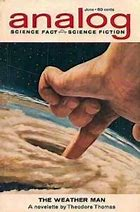There are no microbes. Immobile units powered by molecular solar batteries break down ores, manufacture alloys and concentrate dielectric energy, using reagents like acids in glass. Mobile units extract processable metal and reuseable parts from each other. More complex machines divide into large, tall four-armed bipedal hunters and low, wide, bulky, two-armed octopodal reproducers. (The Arvelan sexes also differ in size.) Reproductive crystallization begins when the two body patterns heterodyne in electric currents and magnetic fields. When complete, the new unit is activated.
Because the new unit that One is creating is almost complete, Zero, who has lost one of his four hands, is able to thrust his arm stump into her repair orifice and, after a while, withdraw it with a new hand. While inside, the stump was enfolded and scanned by interior tendrils. Meanwhile, the new unit's synaptic pathways gradually crystalize from solution. When one of its motor impulse pathways has been completed, the unit stirs within One. That word, "synaptic," addresses my question: how can these self-reproducing artefacts feel anything?

1 comment:
Kaor, Paul!
I'm bemused by the idea of a "female" von Neumann machine being "pregnant"!
Ad astra! Sean
Post a Comment